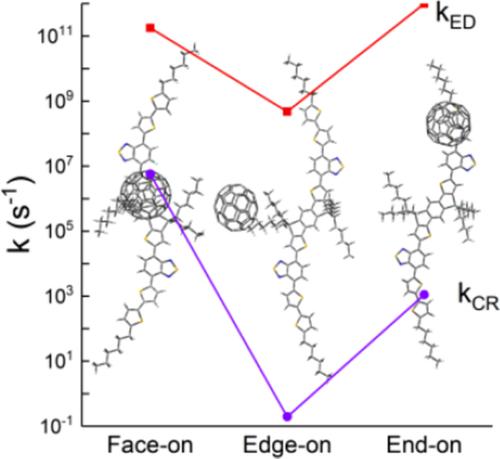当前位置:
X-MOL 学术
›
Int. J. Quantum Chem.
›
论文详情
Our official English website, www.x-mol.net, welcomes your feedback! (Note: you will need to create a separate account there.)
Interface configuration effects on excitation, exciton dissociation, and charge recombination in organic photovoltaic heterojunction
International Journal of Quantum Chemistry ( IF 2.2 ) Pub Date : 2019-11-14 , DOI: 10.1002/qua.26103 Rui‐Rong Bai 1, 2 , Cai‐Rong Zhang 1, 2, 3 , You‐Zhi Wu 1 , Li‐Hua Yuan 2 , Mei‐Ling Zhang 2 , Yu‐Hong Chen 2 , Zi‐Jiang Liu 4 , Hong‐Shan Chen 3
International Journal of Quantum Chemistry ( IF 2.2 ) Pub Date : 2019-11-14 , DOI: 10.1002/qua.26103 Rui‐Rong Bai 1, 2 , Cai‐Rong Zhang 1, 2, 3 , You‐Zhi Wu 1 , Li‐Hua Yuan 2 , Mei‐Ling Zhang 2 , Yu‐Hong Chen 2 , Zi‐Jiang Liu 4 , Hong‐Shan Chen 3
Affiliation

|
The morphology of donor‐acceptor heterojunction interface significantly affects the electron/hole processes in organic solar cells, including charge transfer (CT), exciton dissociation (ED), and charge recombination (CR). Here, to investigate interface molecular configuration effects, the donor‐acceptor complexes with face‐on, edge‐on, and end‐on configurations were constructed as model systems for the p‐SIDT(FBTTh2)2/C60 heterojunction. The geometries, electronic structures, and excitation properties of monomers and the complexes with three configurations were studied based on density functional theory (DFT) and time‐dependent DFT calculations with optimally tuned range separation parameters and solid polarization effects. In terms of Marcus theory, the rate constants of ED and CR processes were analyzed. The results show that most of the excited states for p‐SIDT(FBTTh2)2 exhibit an intramolecular CT character, and the similarity of the excitation characters (CT and local excitation) and energies among three complexes with different configurations indicate that the electronic structure and excitation properties are insensitive to the interfacial molecular configurations. However, the rates of ED and CR processes heavily depend on it. These results underline the importance of controlling molecular configuration and then the morphology at the heterojunction interface in organic solar cells.
中文翻译:

界面配置对有机光伏异质结中的激发,激子解离和电荷复合的影响
供体-受体异质结界面的形态会显着影响有机太阳能电池中的电子/空穴过程,包括电荷转移(CT),激子解离(ED)和电荷重组(CR)。在这里,为了研究界面分子构型的影响,将具有正面,边缘和末端构型的供体-受体复合体构建为p-SIDT(FBTTh 2)2 / C 60的模型系统。异质结。基于密度泛函理论(DFT)和时变DFT计算,优化了范围分离参数和固体极化效应,研究了单体和具有三种构型的配合物的几何结构,电子结构和激发性质。根据Marcus理论,分析了ED和CR过程的速率常数。结果表明,大多数p-SIDT(FBTTh 2)2的激发态表现出分子内的CT特性,并且具有不同构型的三种配合物之间的激发特性(CT和局部激发)和能量的相似性表明,电子结构和激发性质对界面分子构型不敏感。但是,ED和CR过程的速率在很大程度上取决于它。这些结果强调了控制分子构型以及然后控制有机太阳能电池中异质结界面处的形态的重要性。
更新日期:2020-01-07
中文翻译:

界面配置对有机光伏异质结中的激发,激子解离和电荷复合的影响
供体-受体异质结界面的形态会显着影响有机太阳能电池中的电子/空穴过程,包括电荷转移(CT),激子解离(ED)和电荷重组(CR)。在这里,为了研究界面分子构型的影响,将具有正面,边缘和末端构型的供体-受体复合体构建为p-SIDT(FBTTh 2)2 / C 60的模型系统。异质结。基于密度泛函理论(DFT)和时变DFT计算,优化了范围分离参数和固体极化效应,研究了单体和具有三种构型的配合物的几何结构,电子结构和激发性质。根据Marcus理论,分析了ED和CR过程的速率常数。结果表明,大多数p-SIDT(FBTTh 2)2的激发态表现出分子内的CT特性,并且具有不同构型的三种配合物之间的激发特性(CT和局部激发)和能量的相似性表明,电子结构和激发性质对界面分子构型不敏感。但是,ED和CR过程的速率在很大程度上取决于它。这些结果强调了控制分子构型以及然后控制有机太阳能电池中异质结界面处的形态的重要性。



























 京公网安备 11010802027423号
京公网安备 11010802027423号